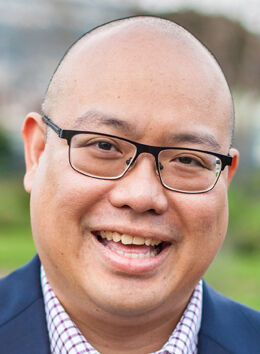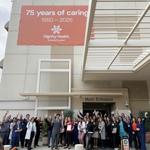South San Francisco’s District 2 seat is up for grabs this November, with one incumbent in the race, Councilmember Mark Nagales, as well as one new candidate, Vivian Ramos.
Nagales has been on the council for six years and has worked on legislative policy at the local, state and federal level for much of his career. Ramos has lived in the city for more than 20 years and has been a leader for various global financial firms.
City budget and COVID-19 transition
South San Francisco received one of the largest amounts of American Rescue Plan Act funds of any jurisdiction on the Peninsula during the pandemic, which it used to fund a variety of programs, including a guaranteed income pilot and broadband expansion project.
The funds helped the city’s budget operate in the black for some time, but it’s now projecting an $8 million deficit this fiscal year 2024-25, which began in July.
Ramos said the city has not sufficiently planned for the ebbs and flows of yearly revenue and expenditures, contributing to the shortfall it’s currently seeing.
As someone who has worked in financial leadership positions for multinational companies, she said it’s important that elected officials also have a strong background in budgetary planning, both short and long term, as that could have helped them better invest the ARPA funds.
“When you have a structural deficit, you can actually see it,” Ramos said. “This is not an unexpected plan. I don’t think there is anyone on the council that really has a finance background.”
Nagales said that, even with the deficit, South City residents have not felt the impacts due to careful planning by council and staff. City departments had to plan for 5% cuts across the board, but that didn’t result in layoffs or a cut in services.
He also added that some of the city’s revenue comes from developer impact fees, which help pay for a variety of programs and services, such as child care, parks and affordable housing. But macroeconomic conditions, like higher costs and a more stringent lending environment, have slowed down construction regionally and statewide. Nagales said he wants the city to reevaluate the high fees, which, if lowered, could spur more development and revenue.
“Developers have to pay an exorbitant amount of fees,” Nagales said. “I’ve asked staff to look at next year’s impact study to see if we can reduce those impact fees to generate more construction, because we need more construction to come in.”
Municipal Services Building and development pushback
The MSB, located on Arroyo Drive, housed several city services and departments for decades, including parks and recreation activities, though its programs were transferred to the Library and Parks and Recreation Center across the street, which opened at the end of last year.
The move has since angered many residents who have consistently shown up to council meetings stating they want it to reopen as an additional community center, not housing, as the new recreation center does not have ample parking and is not designed well.
It’s become one of the most contentious issues the city faces. Residents, many of them seniors, have called for the building’s removal from the city’s housing element, a state-mandated blueprint that identifies potential sites for residential development. Pro-housing advocates, however, have stated the new recreation center offers more programs than the MSB ever did and that the movement is really to stop what they fear would be a potential character change of the neighborhood if affordable housing is built there.
Both Ramos and Nagales said the city waited too long to engage with residents’ concerns over the MSB’s future.
“It’s just taking too long. We should just look at how much it is to open it up and how much is it to build and not overthink about what we really need to build. That’s easy if we just listen,” Ramos said.
Recommended for you
Nagales added it’s also imperative that the city understand not just what the community wants, but it needs to look at financial feasibility and have conversations with developers over what is realistic for them to provide.
“We are going to be doing a feasibility study, because the community could say, ‘we want to do X, Y and Z,’ but if it’s going to cost millions and millions of dollars to do, we need to have a real conversation about what is affordable,” Nagales said. “What’s going to matter to the developer is what pencils out.”
The issue speaks to a broader conundrum many cities across the county and Bay Area face. While the state has cracked down on cities who impede housing production, not everyone is happy with the results. South City needs to plan for almost 4,000 more housing units between 2023-31 — 35% of which must be for low-income households — and it’s been designated housing-friendly by the state, garnering millions of funding dollars as a result. But some longtime residents are pushing back on what they say has gone too far.
Nagales said the city has done extensive outreach and understands the concerns of residents in places like Old Town, where a lot of new development has been concentrated over the years. But a lot more development sites have been identified along El Camino Real and along areas that are close to the BART, Caltrain or bus lines.
“What we want to do is build in transit-oriented development,” Nagales said. “A lot of people are complaining that there is a lot of congestion … when you plan to build next to transit-oriented development, you’re relieving the traffic along those areas.”
Ramos said the city needs to facilitate better relationships between residents and life science firms, the latter of which has the ability to provide more opportunities within their local communities, whether it’s more targeted financial support, such as grant funding, or educational outreach.
“We have 2,000 [job] openings in biotech that people don’t even know about. A thousand of those are life sciences positions, but a thousand aren’t,” she said. “Unless they see reality wherein the [corporations] are actually down there, putting their money where their mouth is, providing help directly, there could be more understanding.”
Environmental goals
Both Ramos and Nagales said they support efforts to reduce carbon emissions, but it just takes a measured approach and does not rely on outright bans.
Mandating all-electric infrastructure for new construction is important, Nagales said, but it’s unrealistic to require older, single-family homes to swap out their entire infrastructure to be fully electric.
“I agree we should do it for new development because the cost can be softened by the developer, but where I have a problem is asking the old buildings to upgrade to electric, because that’s extremely expensive to do, and there isn’t enough money from [Peninsula Clean Energy] or the city to subsidize that,” Nagales said.
Ramos noted environmental efforts should be an extension of one’s personal choices, like recycling or perhaps driving electric vehicles.
“To say that you can no longer have a gas stove,” Ramos said. “I don’t think we need to make that decision right now.”
Environment and transit advocates throughout the county have also raised concern over the Highway 101 managed lane project, which opened toward the beginning of 2023 and stretches 22 miles from the Santa Clara County line to Interstate 380. The tolls adhere to a variable pricing structure, in which costs fluctuate depending on traffic congestion.
Since its rollout, transit agencies like SamTrans and the Transportation Authority have not been able to provide much conclusive data on whether the initiative, which added a new lane to the highway, has actually decreased congestion or pollution since its implementation. Those are important questions to answer before making a decision on whether to extend the express lane north of Interstate 380 and into South City, Nagales said.
“I need to know what the data is, in terms of what this is going to cause for vehicle miles traveled. Is it going to cause more CO2 emissions in the neighborhood? Is it going to cause more traffic?” Nagales, who is a TA board member, said. “We need to see that data.”
The election will be Tuesday, Nov. 5.


































(0) comments
Welcome to the discussion.
Log In
Keep the discussion civilized. Absolutely NO personal attacks or insults directed toward writers, nor others who make comments.
Keep it clean. Please avoid obscene, vulgar, lewd, racist or sexually-oriented language.
Don't threaten. Threats of harming another person will not be tolerated.
Be truthful. Don't knowingly lie about anyone or anything.
Be proactive. Use the 'Report' link on each comment to let us know of abusive posts.
PLEASE TURN OFF YOUR CAPS LOCK.
Anyone violating these rules will be issued a warning. After the warning, comment privileges can be revoked.